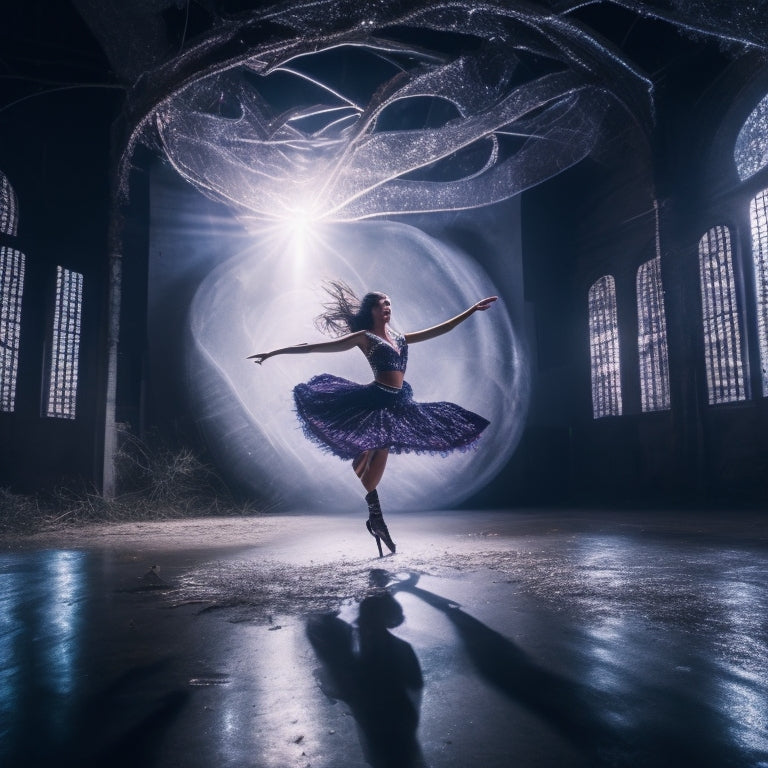
Revolutionizing Dance Performance: Site-Specific Innovations
Share
Site-specific dance performances are revolutionizing the traditional understanding of performance spaces by dissolving the boundaries between performer and audience, creating a more intimate and immersive experience that redefines the role of space in dance. Unconventional venues enable new levels of audience interaction and connection, while creative adaptations and logistical planning overcome site-specific challenges. Further, innovative production elements like lighting, sound, and costume design enhance the narrative and visual interest, transforming the space into an immersive environment. As the possibilities of site-specific dance continue to unfold, new frontiers of creativity and audience engagement await exploration.
Key Takeaways
• Site-specific dance performances redefine the performer-audience-space relationship, creating a more immersive experience.
• Unconventional venues enable a deeper connection and interaction with the audience, dissolving boundaries between performers and spectators.
• Creative adaptations and audience interaction are key to overcoming site-specific challenges and logistical limitations.
• Lighting, sound, costume, and set design amplify the dance performance, evoking emotions and enhancing the narrative.
• Projection mapping adds visual complexity, further immersing the audience in the performance and narrative.
Redefining Traditional Performance Spaces
Beyond the confines of traditional proscenium arches, site-specific dance performances redefine the relationship between the performer, audience, and space, liberating dance from the constraints of conventional stages. This shift enables site-specific adaptations, where dancers and choreographers respond to the unique characteristics of unconventional venues, creating immersive experiences that dissolve the boundaries between performer and audience.
By abandoning traditional stages, site-specific performances foster a deeper sense of connection and interaction between the audience and the dance. The unconventional settings also encourage a more nuanced understanding of the spatial dynamics, allowing the audience to engage with the performance on a more intimate level.
As a result, site-specific dance performances offer a fresh perspective on the art form, one that is more inclusive, interactive, and experiential.
Overcoming Site-Specific Challenges
Routinely, site-specific dance performances encounter a unique set of challenges that test the creativity and adaptability of dancers, choreographers, and production teams. To overcome these challenges, a focus on creative adaptations and audience interaction is crucial.
To guarantee successful site-specific performances, consider the following:
-
Audience integration: Encourage audience participation and immersion in the performance space.
-
Environmental adaptations: Tailor the performance to the specific site, incorporating its unique features and constraints.
-
Logistical planning: Carefully plan and coordinate the production to accommodate the site's limitations and possibilities.
- Improvisation and flexibility: Remain open to changes and unexpected events, and be prepared to adapt the performance accordingly.
Amplifying Dance Through Production
By strategically incorporating production elements, dancers and choreographers can elevate the emotional resonance and visual appeal of site-specific performances, ultimately amplifying the dance itself. Effective production elements can enhance the atmosphere, creating an immersive experience that engages the audience on a deeper level.
| Production Element | Impact on Performance |
| Lighting Design | Creates mood and atmosphere, highlighting dancers' movements |
| Sound Design | Evokes emotions, sets tone, and enhances narrative |
| Costume Design | Adds visual interest, conveys character, and enhances theme |
| Set Design | Transforms space, creating an immersive environment |
| Projection Mapping | Adds visual complexity, enhancing narrative and atmosphere |
Frequently Asked Questions
What Inspires Dancers to Choose Unconventional Performance Spaces?
Dancers are inspired to choose unconventional performance spaces by the pursuit of artistic freedom, driven by the desire to break free from traditional constraints and explore new urban landscapes, fostering innovative and immersive experiences.
How Do Site-Specific Performances Change Audience Participation?
Can traditional audience passivity be replaced by dynamic engagement? Site-specific performances revolutionize audience participation by offering immersive experiences, fostering interdisciplinary collaborations, and dissolving boundaries between performer and spectator, creating a symbiotic relationship that redefines the dance experience.
Can Traditional Dance Techniques Be Adapted for Site-Specific Works?
Traditional dance techniques can be adapted for site-specific works by embracing Corporeal Expression, which prioritizes bodily awareness, and Kinetic Freedom, which fosters improvisational movement, allowing dancers to respond organically to unconventional spaces and engage audiences in innovative ways.
What Role Does Technology Play in Enhancing Site-Specific Performances?
Technology greatly enhances site-specific performances through innovative applications, such as Virtual Projections and Interactive Mapping, which create immersive experiences, redefine spatial boundaries, and foster dynamic audience engagement.
How Do Outdoor Performances Impact Environmental Awareness?
Outdoor performances can foster eco-activism by raising environmental awareness, promoting urban renewal, and encouraging community engagement, ultimately inspiring a sense of responsibility towards the environment and urban spaces.
Related Posts
-

Video Courses to Perfect Dance Makeup Skills Online
You can now refine your dance makeup skills with online video courses that cater specifically to the unique demands o...
-

Unlock Your Creativity With Dancing Sublimation File
Dancing Sublimation File is a creative catalyst that opens up a world of vibrant design possibilities, providing high...
-

Get Crafty! Dance SVG Digital File
Elevate your DIY projects with the Get Crafty! Dance SVG Digital File, featuring 10 unique designs tailored for dance...


